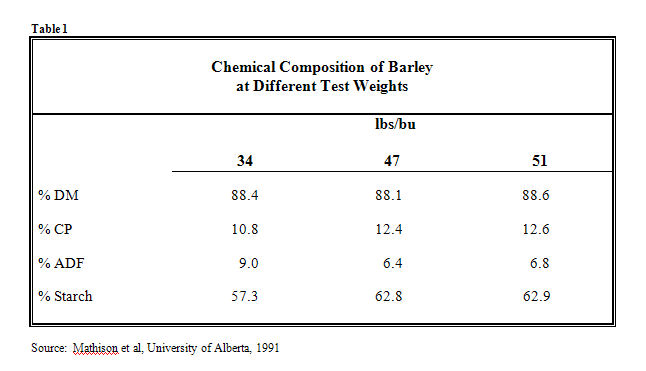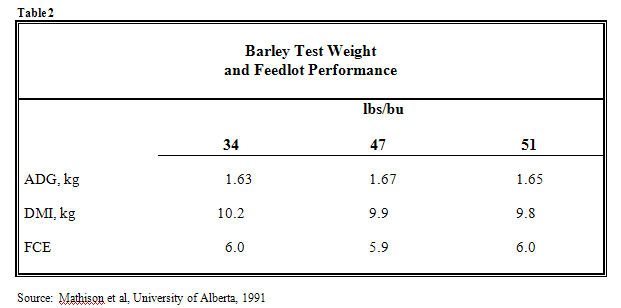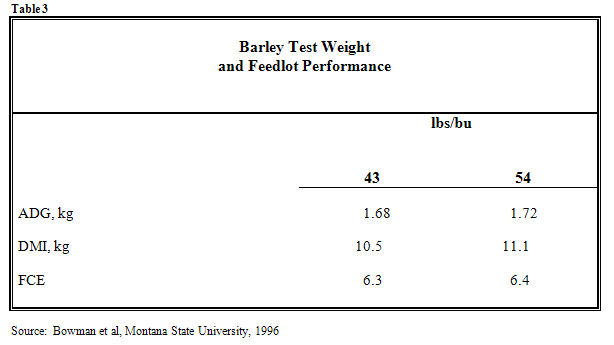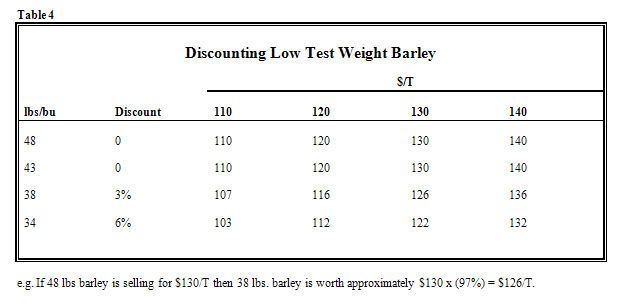Feeding Frozen Grain to Cattle
Frozen grain can be fed successfully to cattle and, when available, can be a cost-effective energy source.
Grains are used as energy supplements for ruminants and their feed value is therefore based on energy content. Unfortunately, there is no easy and inexpensive method to determine energy content. Over the years, people have attempted to correlate test weight (a fast, inexpensive determination) to energy content and animal performance.
Each grain has a typical test weight. Many factors, however, such as maturity, disease, kernel shape and size influence test weight. Immature grain, due to early frosts and freezing is a common cause of low test weights. Immature grain has a lower starch and higher fiber content than mature grain (Table 1). Because animals derive energy from the starch present in grain, one might expect a low test weight to be associated with decreased performance.
Barley: Feeding trials performed with barley as low as 34 lbs/bu show no differences in average daily gain with a trend towards decreased feed efficiency after 43 lbs. (Tables 2 & 3). The reported drops in feed efficiency with low test weight barley vary from 4 - 10%.
Barley with test weights lower than 43 lbs should be discounted somewhat to compensate for reduced feed efficiency (Table 4). Feeding barley with test weights above 48 lbs does not result in superior performance and should not command a price premium.
Corn: Results from a two year research project at the University of Nebraska (1996 Nebraska Beef Cattle Report) showed that corn with test weights of 46 and 56 lbs per bushel resulted in identical gain and feed efficiency when fed to growing and finishing steers.
Oats: Energy (TDN) values were calculated for 11 oat samples of varying test weights (21.7 – 33.5 lb/bu) using both proximate analysis and ADF (Dupchak, 2000). The TDN of oats with bushel weights less than 24 lbs was approximately 95% of the NRC value of 76% TDN.
Wheat: Few differences in animal performance have been noted when the bushel weight of wheat is over 50 lbs (Marston et al, 2004). If the bushel weight drops to between 45 and 50 lbs per bushel, the feeding value decreases by approximately 5%.
Summary:
- Barley with test weights of 43 and 48 lbs/bu will result in similar gain and feed efficiency.
- Barley with a test weight lower than 43 lbs/bu will likely result in reduced feed efficiency.
- Corn with test weights of 46 and 56 lbs/bu will result in similar gain and feed efficiencies.
- Light weight oats (to 21.7 lbs/ bu) appears to have good feed value.
- Wheat with a test weight of 50 lbs/bu has a similar energy content to 60 lb/bu wheat.
- A premium should not be paid for higher than average test weight grains.
- Light weight grains should be fed by weight, not volume, to minimize effects of changing test weights.
- Grains of varying test weight should not be mixed together prior to processing. This can make uniform processing very difficult.




Literature Cited
Boss, D. L. and J.G.P. Bowman. 1996. Barley Varieties for Finishing Steers: 1. Feedlot performance, in vivo diet digestion and Carcass characteristics. J. Anim. Sci. 74:1967.
Dupchak, K. 2000. Estimating the TDN of low bushel weight oats. Nutrition Update, 11 (2).
Marston, T. and J. DeRouchey. 2004. Feeding low-test-weight and sprouted wheat. Kansas State University, August 2004.
Mathison, G.W., R. Hironaka, B.K. Kerrigan, I. Vlach, L.P. Milligan, and R.D. Weisenburger. 1991. Rate of starch degradation, apparent digestibility and rate and efficiency of steer gain as influenced by barley grain volume-weight and processing method. Can. J. Anim. Sci. 71: 867.
Rush, I., B. Weichenthal, B. Van Pelt. 1996. Feeding value of light test weight corn for growing and finishing steers. 1996 Nebraska Beef Cattle Report.
For more information

